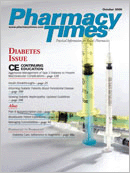Publication
Article
Pharmacy Times
Rx Product News
Accuzyme (papain, urea)
Marketed by: Healthpoint Ltd (Fort Worth, Tex)
Indication: May 22, 2006?Healthpoint announced the launch of a new spray emulsion delivery formulation for its wound-care treatment, Accuzyme (as well as Panafil [papain, urea, chlorophyllin copper complex sodium]). Accuzyme is indicated for debridement of necrotic tissue and liquefaction of slough in acute and chronic lesions such as pressure ulcers, varicose and diabetic ulcers, burns, postoperative wounds, pilonidal cyst wounds, carbuncles, and miscellaneous traumatic or infected wounds. This new delivery form is designed to reduce the risk of infection and disturbance to wounds.
Dosage Form: 33-mL spray bottle
For More Information: www.healthpoint.com 800-441-8227
Actonel (risedronate sodium tablets)
Marketed by: The Alliance for Better Bone Health (a collaboration between Procter & Gamble Pharmaceuticals Inc and sanofi-aventis US)
Indication: August 1, 2006?The FDA approved Actonel 35 mg for treatment to increase bone mass in men with osteoporosis. Actonel 35 mg is also approved for the prevention and treatment of osteoporosis in postmenopausal women. Actonel 5 mg was approved by the FDA in 2000 for daily use in men and women to prevent and treat certain forms of steroid-induced osteoporosis.
Dosage Form: Tablets: 5 mg daily; 35 mg once a week
For More Information: www.actonel.com
Exelon (rivastigmine tartrate)
Marketed by: Novartis Pharmaceuticals Corp (East Hanover, NJ)
Indication: June 27, 2006?Novartis Pharmaceuticals announced that the FDA has approved Exelon for the treatment of mild-to-moderate Parkinson's disease dementia, making it the first medication available for the treatment of this condition. Exelon is also indicated for the treatment of mild-to-moderate Alzheimer's disease.
Dosage Form: Capsules: 1.5, 3, 4.5, and 6 mg Oral solution: 2 mg/mL
For More Information: wwww.exelon.com
Keppra (levetiracetam)
Marketed by: UCB Inc (Smyrna, Ga)
Indication: August 23, 2006?The FDA approved an additional indication for Keppra?as adjunctive therapy in the treatment of myoclonic seizures in adults and adolescents 12 years of age and older with juvenile myoclonic epilepsy. Keppra is also indicated as an adjunctive therapy in the treatment of partial-onset seizures in adults and children 4 years of age and older with epilepsy.
Dosage Form: Tablets: 250, 500, 750, and 1000 mg Oral solution: 100 mg/mL
For More Information: www.keppra.com 866-822-0068
Lucentis (ranibizumab injection)
Marketed by: Genentech Inc (South San Francisco, Calif)
Indication: June 30, 2006?Genentech Inc received FDA approval for Lucentis for the treatment of neovascular (wet) age-related macular degeneration. The FDA approved Lucentis after a 6-month priority review. Lucentis is a recombinant humanized IgG1 kappa isotype therapeutic antibody fragment developed for intraocular use. Lucentis binds to and inhibits the biologic activity of human vascular endothelial growth factor A, a protein that is believed to play an important role in angiogenesis (the formation of new blood vessels).
Dosage Form: Intravitreal injection: 0.5 mg once a month
For More Information: www.lucentis.com 866-LUCENTIS (866-582-3684)
Plavix (clopidogrel bisulfate)
Marketed by: Bristol-Myers Squibb/Sanofi Pharmaceuticals partnership (New York, NY)
Indication: August 17, 2006?The FDA approved a new medical use for Plavix. The product is now indicated for patients who have had a type of heart attack known as acute ST-segment elevation myocardial infarction, who are not going to have coronary artery repair. The FDA originally approved Plavix in 1997 to decrease platelet function in people who suffer from acute coronary syndrome.
Dosage Form: Tablets: 75 mg
For More Information: www.plavix.com
Qualaquin (quinine sulfate capsules, USP)
Marketed by: Mutual Pharmaceutical Co/ AR Scientific (Philadelphia, Pa)
Indication: July 11, 2006?Mutual Pharmaceutical Co/AR Scientific announced the commercial introduction of Qualaquin for the treatment of uncomplicated Plasmodium falciparum malaria. Qualaquin is the first and only formulation of quinine sulfate to be approved by the FDA.
Dosage Form: Capsules: 324 mg
For More Information: www.urlmutual.com 888-351-3786
Raniclor (cefaclor tablets, chewable)
Marketed by: Pedinol Pharmacal Inc (Farmingdale, NY)
Indication: October 2, 2006?Pedinol Pharmacal will begin promotions of Raniclor chewable cefaclor tablets in accordance with an agreement reached with Ranbaxy Pharmaceuticals. Raniclor is indicated for the treatment of otitis media, pharyngitis, tonsillitis, urinary tract infections lower respiratory tract infections, and skin and skin structure infections caused by certain gram-positive and gram-negative bacteria.
Dosage Form: Chewable tablets: 250 and 375 mg
For More Information: www.pedinol.com 800-PEDINOL (800-733-4665)
Remicade (infliximab)
Marketed by: Centocor Inc (Horsham, Pa)
Indication: August 14, 2006?Remicade was granted approval for an additional indication for inhibiting progression of structural damage and improving physical function in patients with psoriatic arthritis, in addition to reducing signs and symptoms of active arthritis. Remicade has been used to treat over 770,000 patients worldwide with gastroenterologic, rheumatologic, and dermatologic inflammatory diseases.
Dosage Form: Intravenous: 5 mg/kg
For More Information: www.remicade.com 888-779-9769
Glumetza (metformin hydrochloride extended-release tablets)
Marketed by: King Pharmaceuticals Inc (Bristol, Tenn), and Depomed Inc (Menlo Park, Calif)
Indication: September 6, 2006?King Pharmaceuticals and Depomed announced the commercial availability of Glumetza. Glumetza is an oral treatment for type 2 diabetes that offers the benefits of metformin?reliable glycemic control, absence of weight gain, and a low incidence of hypoglycemia?with the added convenience of once-daily dosing.
Dosage Form: Tablets: 500 mg
For More Information: www.glumetzaxr.com 866-458-6389







